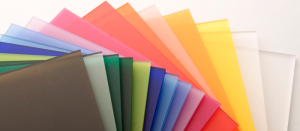
One major characteristic that’s useful to understand when it comes to plastic prototype production and/or plastic part manufacturing is the distinction between thermoplastic and thermoset materials. To make a long story short, thermoplastic materials can be melted, cured (cooled down such that they become solid), melted again, cured again, and so forth. There is a limit to the number of times this process can be repeated depending on the particulars of the given material but the point is that thermoplastic materials can be melted multiple times without significantly degrading the material. Thermoset materials, by contrast can only be melted once. After a thermoset material cures, attempting to heat it again to its melting point would cause it to burn (rather than melt) the material. It is useful to think of a 2-part epoxy when trying to understand thermoset plastics. An epoxy, like a thermoset material, is liquid prior to setting. Once the resin dries, however, it is not possible to melt it again.
When it comes to injection molding it’s easy to misunderstand the relevancy of thermoset and thermoplastic materials. For starters, both thermoset and thermoplastic polymers can be injection molded. The primary difference applies after the injection mold cycle (typically only a few seconds in duration) when the molded plastic cures (solidifies). During injection molding plastic is heated and then injected into a metal “tool” (think of a cube with an internal cavity in the shape of your final part). In order to physically get to the cavity the molten plastic must first pass through a series of tunnels and entry points known as sprues, runners, and gates. Plastic cools every cycle within the mold cavity as well as within these channels that lead to the cavity. The material that solidifies in the sprues, runners, and gates is not part of the final product. It is essentially waste.
In the event that a thermoplastic material is being used for injection molding, it can be recycled and used again (oftentimes this occurs right on the factory floor). Solid material left over after each cycle in the sprues, runners, and gate locations can frequently be combined with the raw material that originally goes into the injection molding press. The same is true with material from rejected parts or the overflow material on the edges of parts where the mold tool was not 100% airtight. All of this plastic (called “regrind”) can be ground up and recycled back into the beginning of the process. This all translates into higher efficiency and ultimately means lower costs for the end consumer and a more competitive or higher margin product for the producer. Of note, that does not mean that a precisely designed mold tool is unnecessary for injection molding with thermoplastics. To the contrary, oftentimes quality control measures limit the amount of regrind that can be reused as a percentage of total plastic to prevent potential degradation of material properties.
In the event that a thermoset material is being used, the solid material from the sprues, runners, and gates is virtually guaranteed to be thrown away as waste. That means that all other things being equal (disclaimer: this is a bad assumption) that the end product will cost more.
As you might imagine, the same characteristics are relevant at the end of a plastic part’s lifecycle when it comes time to either throw away or recycle the material. Consider the plastic water bottles sold millions of times everyday. The 500mL of water inside is consumed in a matter of minutes while the bottle, if thrown into a landfill, would take hundreds of years to biodegrade. The number of plastic bottles in landfills eventually becomes an environmental issue if recycling is not a player in the process. Consequently most plastic bottles are made in whole or at least in part from recycled material. Take a look for yourself. The resin identification code on your plastic bottle is likely to read “1” which identifies materials made from polyethylene terephthalate (PET), a thermoplastic material.
In conclusion, thermoplastics provide some major advantages to manufacturers, consumers, and society in general. The fact that they can be easily recycled means that we are more responsibly stewarding our natural resources while the fact that manufacturing waste can be reused (thus preventing it from becoming “waste” in the first place) makes them a favorable choice if specific material properties aren’t exclusively available with a thermoset material.